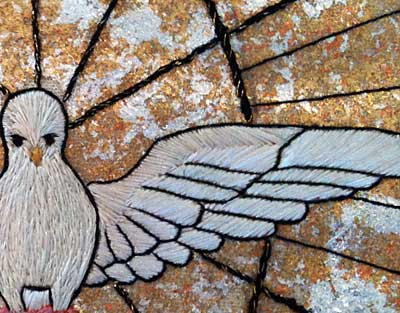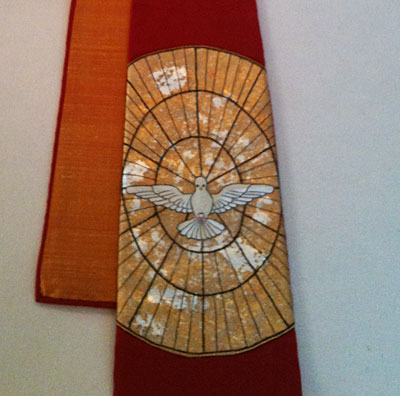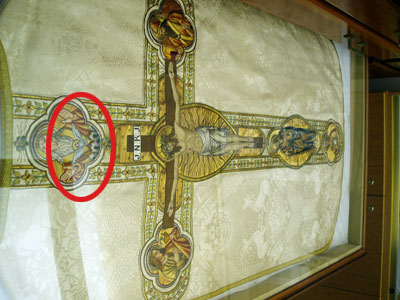In ecclesiastical embroidery – both historical and contemporary – it’s fairly easy to find representations of the Holy Ghost in most collections. The Holy Ghost is symbolically represented as a dove, from Christ’s baptism in Luke 3:22: “And the Holy Ghost descended in a bodily shape, as a dove upon him.” As a symbol, the dove evokes certain images – it is gentle, pure, peaceful. Within larger images on historical vestments, you might look at the whole picture and completely miss the dove, but if you look hard enough in Christian figure embroidery on vestments, sure enough, you’ll often find a little dove figured into the needlepainting somewhere.
Lately, I’ve been in touch with several embroiderers out there who have been working on different pieces of ecclesiastical embroidery for Pentecost. A couple sent photos, so I’d like to share them, and I’ll also show you some photos of historical pieces with the Holy Ghost discreetly figured into the embroidery.

This first piece is a banner embroidered by Eileen Thompson. She worked the embroidery on linen first, and then cut it out and applied it to the red velvet background.

Eileen worked the dove in wool threads, in long and short stitch on the body, and fishbone stitch on the feathers. She used a metallic thread to outline the entire dove and all the wing details. Up close, the shading is a yellowy-cream color, but when viewed from far away, it blends into the white to look like the shadows that give definition to the shape of the dove. With church embroidery, this shading and outlining is important, because the pieces are meant to be seen from far away. The contrast between the white and the yellow and the contrast between the white and the outlines (in gold and red) are what make the details of the piece stand out from a distance.

Anne Gomes took a completely unique approach to creating this image for a Pentecost stole. She used the Bernini window at St. Peter’s Basilica in Rome as inspiration. Working on a ground of Japanese obi silk, she gold-leafed the fabric with combinations of real gold, real copper leaf, and real silver leaf. The dove is stitched in flat silk, with long and short stitch, and outlined with black flat silk.

You can see here a close up on the stitching and on the background, with the combination of the different gold leafing.

The stole was constructed from a brocade blend fabric, in Pentecost Red, and the lining of the stole is a red-gold silk dupioni.

Going back to the image of the Holy Ghost showing up in larger figure embroidery (“pictures” on vestments of old), here you can see the Holy Ghost depicted at the Annunciation on the back of this cope.

Though centrally located in the whole embroidered image, the dove might be easily overlooked – it is subtle, compared to the vivid colors of the embroidered figures.

Here again is a small image of the dove, hovering above a large image of God the Father on the back of this cope.

You can see the small dove over the right shoulder (left of the picture). Unfortunately, this piece was stored in a deep drawer, and this was the best angle at which I could get a full shot of the whole cope hood!

Up close, this embroidered dove looks fairly large. In fact, it is tiny, subtly present in the embroidery that adorns this chasuble:

Another photo of a piece in storage – the red circle on the left of the photo shows you where the dove figures into the overall embroidered image. Incidentally, the dove is only approximately 2″ high.

Here’s another little dove – again only a few inches in circumference. This one is located on the front panels that decorate another cope illustrating the Annunciation:

The red circle outlines the location of the above embroidered symbol in context with the rest of the embroidered panels.

Sometimes, doves figure into ecclesiastical embroidery as symbolic elements, without necessarily representing the Holy Ghost. Here, for example, is a dove held on the hand of an embroidered saint. How to distinguish this as a symbol of peace and purity in general (in association with the particular saint), or a symbol of the Holy Ghost? Notice the lack of the nimbus or halo around the bird. If the bird were meant to represent God, the artists designing and embroidering the piece would have certainly surrounded the dove with some kind of representative halo. The more elaborate the halo, in fact, the “higher the rank” in ecclesiastical symbolism. So the saint has a halo, but the dove doesn’t – it is not meant to represent the Holy Ghost in this particular image.
So there’s a little glimpse of some of the symbolic elements of church embroidery! Thanks to Anne and Eileen for the inspiration & the pictures of their pieces!







What beautiful work! I am fascinated by ecclesiastical goldwork. Many years ago, I had a house exchange in Liverpool, England and spent hours gawking at the collection of Victorian and Edwardian English church embroidery in the Embroidery Museum in the Anglican Cathedral. Even though the works are not that old, they are magnificent. Some of the pieces and lots of other English ecclesiastical embroidery can be found in a book that I don’t think you’ve mentioned, Mary. It’s by Mary Schoeser, “English Church Embroidery, 1833 – 1953.” London: Watts & Co., 2nd ed. 1998. ISBN 0 9533265 0 0.
That last picture blew me away. She shadows on her habit look so lifelike! Someday I’ll be able to do that.
What a beautiful way to end a busy Sunday–enjoying pictures of such richly embroidered pieces! Thanks for posting them Mary.
Firstly, thank you Mary for this post. I love seeing ecclesiastical work through your eyes. I know so little about it, so I really appreciate all the information you provide along side the beautiful photographs.
Thanks also to Eileen and Anne for allowing you to share pictures of their work with us. Both the designs are wonderful (I also enjoyed the link to the original stain glass window) and the embroidery is exquisit.
Dear Mary,
Thank you for the lovely photos of the embroidered representations of the Holy Spirit on Pentecost Sunday. They are beautiful!
Will you be able to upload any embroidered depictions of the Trinity for nest week? (Next Sunday is Trinity Sunday.) My husband and I would be very interested in those.
Have a blessed week.
Doris HH
I can only respond with “wowzer”! Absolutely amazing work and such lovely represenations. I can’t tell you how much I appreciate your thoughts and comments as well. As a side note, it is extra special as related to something my teens experienced in their senior humanities class in high school. A majority of the students massively struggled with the art portions of the class due to their lack of religious training – they had no idea nor reference point how to interpret most renaissance or middle ages art; not to mention nonChristian references either. Thank you for a blast of beauty!
What gorgeous work!
I think the saint is St Milburga, Abbess of Wenlock. She was famous for her relationship with birds. A nice connection with the Holy Spirit though is that when she healed (in some accounts raised) a sick child she appeared to hover for a few minutes in warm, life-giving flames.
Mary
Thanks for the beautiful pictures. I am a seed bead artist and have been doing Christian symbols using seed beads, size 11 and smaller. I am learning how to make priest’s stoles and want to learn about the symbols that are correct for decorating the stoles. Do you know of a collection of patterns and meanings of Christian symbols for such purpose? Thanks for info
Hi, Becky – I have a collection of church patterns available here on Needle ‘n Thread in the shop. They’re not specifically for bead embroidery, but they can be adapted. There are some books out there on Christian symbolism – I have a couple in my library, but I don’t know the names off hand. A search on Amazon would probably produce a few results. When I get a chance to burrow in my bookshelves, I’ll see which ones I have on hand. There are also quite a few websites out there that could help you out. -MC
God is amazing, I just read this article yesterday & today I learned my 5 year old niece has given her life to God. Now with all of the information you shared about Ecclesiastical embroidery I’m sufficiently prepared to make her Baptism gift.
Dear Ms. Corbet,
Thank you for all you share on ecclesiastical embroidery. I am not an embroiderer, but a designer who loves this work. I aspire to give God glory in this line of work but have no experience or leads in this direction. Maybe you have advice for me. I am constantly inspired by the beautiful vestments worn by the priests when we attend Latin Mass every Sunday. Do you have any ideas on where I can start? Thank you, most kindly. Gem
Hi, Gem – Are you looking to get into ecclesiastical embroidery, or are you asking about designing tips? If the former, I’d start by learning needlepainting techniques (silk shading) and basic goldwork. The best beginner book for the initial type of silk shading and goldwork you’d encounter with ecclesiastical embroidery is Beginner’s Guide to Goldwork by Ruth Chamberline, which you can read about here: https://needlenthread.wpengine.com/2017/02/beginners-guide-to-goldwork-new-edition.html. That will get you started!